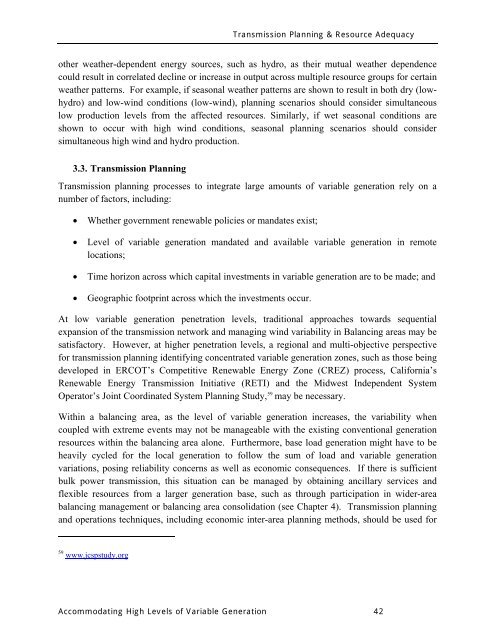Accommodating High Levels of Variable Generation - NERC
Accommodating High Levels of Variable Generation - NERC
Accommodating High Levels of Variable Generation - NERC
Create successful ePaper yourself
Turn your PDF publications into a flip-book with our unique Google optimized e-Paper software.
Transmission Planning & Resource Adequacy<br />
other weather-dependent energy sources, such as hydro, as their mutual weather dependence<br />
could result in correlated decline or increase in output across multiple resource groups for certain<br />
weather patterns. For example, if seasonal weather patterns are shown to result in both dry (lowhydro)<br />
and low-wind conditions (low-wind), planning scenarios should consider simultaneous<br />
low production levels from the affected resources. Similarly, if wet seasonal conditions are<br />
shown to occur with high wind conditions, seasonal planning scenarios should consider<br />
simultaneous high wind and hydro production.<br />
3.3. Transmission Planning<br />
Transmission planning processes to integrate large amounts <strong>of</strong> variable generation rely on a<br />
number <strong>of</strong> factors, including:<br />
• Whether government renewable policies or mandates exist;<br />
• Level <strong>of</strong> variable generation mandated and available variable generation in remote<br />
locations;<br />
• Time horizon across which capital investments in variable generation are to be made; and<br />
• Geographic footprint across which the investments occur.<br />
At low variable generation penetration levels, traditional approaches towards sequential<br />
expansion <strong>of</strong> the transmission network and managing wind variability in Balancing areas may be<br />
satisfactory. However, at higher penetration levels, a regional and multi-objective perspective<br />
for transmission planning identifying concentrated variable generation zones, such as those being<br />
developed in ERCOT’s Competitive Renewable Energy Zone (CREZ) process, California’s<br />
Renewable Energy Transmission Initiative (RETI) and the Midwest Independent System<br />
Operator’s Joint Coordinated System Planning Study, 59 may be necessary.<br />
Within a balancing area, as the level <strong>of</strong> variable generation increases, the variability when<br />
coupled with extreme events may not be manageable with the existing conventional generation<br />
resources within the balancing area alone. Furthermore, base load generation might have to be<br />
heavily cycled for the local generation to follow the sum <strong>of</strong> load and variable generation<br />
variations, posing reliability concerns as well as economic consequences. If there is sufficient<br />
bulk power transmission, this situation can be managed by obtaining ancillary services and<br />
flexible resources from a larger generation base, such as through participation in wider-area<br />
balancing management or balancing area consolidation (see Chapter 4). Transmission planning<br />
and operations techniques, including economic inter-area planning methods, should be used for<br />
59 www.jcspstudy.org<br />
<strong>Accommodating</strong> <strong>High</strong> <strong>Levels</strong> <strong>of</strong> <strong>Variable</strong> <strong>Generation</strong> 42
















